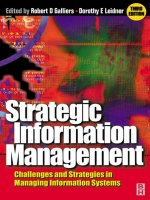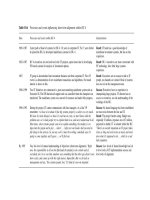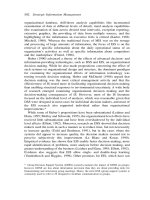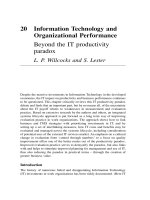Managing information systems 7th edition brow ch06
Bạn đang xem bản rút gọn của tài liệu. Xem và tải ngay bản đầy đủ của tài liệu tại đây (816.49 KB, 39 trang )
MANAGEMENT INFORMATION SYSTEMS
CHAPTER 6
MANAGERIAL SUPPORT SYSTEMS
PART II - APPLICATION AREAS
Intra-organizational systems:
• Enterprise systems: (Ch. 5)
support all or most of the organization
• Managerial Support systems (Ch. 6)
support a specific manager or group of managers
Inter-organizational systems:
• e-Business applications (Ch. 7)
- B2C – link businesses with end consumers
- B2B – link businesses with other businesses
- Intermediaries
Copyright © 2011 Pearson Education, Inc. publishing as Prentice Hall
MANAGERIAL SUPPORT SYSTEMS
•
•
•
•
•
•
•
•
•
•
Decision Support Systems
Data Mining
Group Support Systems
Geographic Information Systems
Executive Information Systems
Business Intelligence Systems
Knowledge Management Systems
Expert Systems
Neural Networks
Virtual Reality
Copyright © 2011 Pearson Education, Inc. publishing as Prentice Hall
DECISION SUPPORT SYSTEMS
• Interactive decision support for complete or poorly structured
problems
• Data often comes from transaction processing systems or data
warehouse
• Incorporates data and models
Copyright © 2011 Pearson Education, Inc. publishing as Prentice Hall
DECISION SUPPORT SYSTEMS
• Three major components:
1. Data management: select
and handle appropriate data
2. Model management: apply
the appropriate model
3. Dialog management:
facilitate user interface to the
DSS
Copyright © 2011 Pearson Education, Inc. publishing as Prentice Hall
DECISION SUPPORT SYSTEMS
• Specific DSS – actual DSS applications that directly assist
in decision making
• DSS generator – a software package (ex. Spreadsheet)
used to build a specific DSS quickly and easily
used to create
DSS Generator
Copyright © 2011 Pearson Education, Inc. publishing as Prentice Hall
DSS Model 1
DSS Model 2
DSS Model 3
DATA MINING
• Employs different technologies to search for (mine) “nuggets” of
information from data stored in a data warehouse
• Decision techniques:
– Decision trees
– Linear and logistic regression
– Association rules for finding patterns
– Clustering for market segmentation
– Rule induction
– Statistical extraction of if-then rules
– Nearest neighbor
– Genetic algorithms
Copyright © 2011 Pearson Education, Inc. publishing as Prentice Hall
ONLINE ANALYTICAL PROCESSING (OLAP)
• Human- driven analysis:
- Querying against a database
- Program extracts data from the database and structures it by
individual dimensions, such as region or dealer
Copyright © 2011 Pearson Education, Inc. publishing as Prentice Hall
USES OF DATA MINING
Copyright © 2011 Pearson Education, Inc. publishing as Prentice Hall
DATA MINING PRODUCT EXAMPLES
• Xerox installed Rapid Insight Analytics software to mine customer order, sales
prospects and supply chain data to develop monthly and quarterly forecasts.
• Farmers Insurance Group uses IBM’s DecisionEdge software to mine data.
• Vermont County store (VCS) a catalog retailer uses SAS’s Enterprise miner
software to segment its customers to create appropriate direct marketing lists.
Data Mining software:
- Oracle 10g Data Mining
- SAS Enterprise Miner
- IBM Intelligent Miner Modeling
- Angoss Software’s Knowledge SEEKER, Knowledge STUDIO, and Strategy
BUILDER
SAS Enterprise Miner
XL Miner
Copyright © 2011 Pearson Education, Inc. publishing as Prentice Hall
DATA MINING
More Data Mining examples
Copyright © 2011 Pearson Education, Inc. publishing as Prentice Hall
GROUP SUPPORT SYSTEMS (GSS)
• Decision support for group meetings
Goal: more productive meetings
• Includes “different time, different place” mode = virtual teams
• Product example:
Group Systems (Purchased by IBM)
Group Systems
Copyright © 2011 Pearson Education, Inc. publishing as Prentice Hall
GROUP SUPPORT SYSTEMS
• Traditional setup for “same-time, same-place” GSS
Copyright © 2011 Pearson Education, Inc. publishing as Prentice Hall
GEOGRAPHIC INFORMATION SYSTEMS
• Systems based on manipulation of relationships in space that use
geographic data
• Early GIS users:
- Natural resource management
- Public administration
- NASA and the military
- Urban planning
- Forestry
- Map makers
Copyright © 2011 Pearson Education, Inc. publishing as Prentice Hall
GEOGRAPHIC INFORMATION SYSTEMS
• Current business uses:
- Determining site locations
- Market analysis and planning
- Logistics and routing
- Environmental engineering
- Geographic pattern analysis
• Applications for mobile users:
- Logistics (fastest route)
- Location intelligence
Copyright © 2011 Pearson Education, Inc. publishing as Prentice Hall
;
GEOGRAPHIC INFORMATION SYSTEMS
• Representation of spatial data:
• Raster-based GISs – rely on dividing space into small, uniform
cells (rasters) in a grid
• Vector-based GISs – associate features in the landscape with a
point, line, or polygon
• “Coverage” data model – different layers represent similar types of
geographic features in the same area and are stacked on top of one
another
Copyright © 2011 Pearson Education, Inc. publishing as Prentice Hall
GEOGRAPHIC INFORMATION SYSTEMS
“Coverage” data model
Copyright © 2011 Pearson Education, Inc. publishing as Prentice Hall
GEOGRAPHIC INFORMATION SYSTEMS
• Organizations can buy off-the-shelf technologies and spatial
data:
- Base maps, zip code maps, street networks, and advertising
media market maps
• Other data sources may be spread throughout the organization
in different internal databases
Copyright © 2011 Pearson Education, Inc. publishing as Prentice Hall
GEOGRAPHIC INFORMATION SYSTEMS
GIS Vendors
•
•
•
•
•
Environmental Research Institute (ESRI)
Pitney Bowes ( with its MapInfo products)
Autodesk
Tactician Corp.
Intergraph Corp.
ESRI
MapInfo
Tactician
Intergraph
Copyright © 2011 Pearson Education, Inc. publishing as Prentice Hall
Executive Information Systems (EIS)/
Business Intelligence Systems
• Hands-on tool that focuses, filters, and organizes information so
that an executive can make more effective use of it
• User base for EISs has expanded to encompass all levels of
management
Today also called performance management software
• Focus on competitive information…
today referred to as business intelligence systems
Copyright © 2011 Pearson Education, Inc. publishing as Prentice Hall
Executive Information Systems/
Business Intelligence Systems
- Delivers online current information about business conditions in
aggregate form
- Filtered and summarized transaction data
- Competitive information, assessments and insights
- Easily accessible to senior executives and other managers
- Designed to be used without intermediary assistance
- Uses state-of-the-art graphics, communications and data storage methods
Copyright © 2011 Pearson Education, Inc. publishing as Prentice Hall
Executive Information Systems/
Business Intelligence Systems
Commercial EIS software
•
•
•
•
•
•
•
•
•
•
•
Executive Dashboard from Qualitech Solutions
Oracle Enterprise performance Management Systems
SAP Business Objects Strategy Management
SAS/EIS
Symphony RPM from Symphony Metreo
IBM Cognos Business Intelligence
MicroStrategy Intelligence Server
Oracle Business Intelligence Suite
Executive Dashboard
SAP Business Objects BI solutions
SAP Business Objects
SAS Business Intelligence
SAS/EIS
Infor PM
Symphony Metreo
Infor PM
Copyright © 2011 Pearson Education, Inc. publishing as Prentice Hall
Executive Information Systems/
Business Intelligence Systems
• “Dashboard” layout for data representation:
Copyright © 2011 Pearson Education, Inc. publishing as Prentice Hall
KNOWLEDGE MANAGEMENT SYSTEMS
What is Knowledge management (KM)?
• Practices to manage Organizational knowledge
• Strategies and processes for identifying, creating,
capturing, organizing, transferring, and leveraging
knowledge held by individuals and the firm
Copyright © 2011 Pearson Education, Inc. publishing as Prentice Hall
KNOWLEDGE MANAGEMENT SYSTEMS
What is a Knowledge management system (KMS)?
• System to help manage organizational knowledge
• Technologies that facilitate the sharing and transferring of
knowledge so that it can be reused
• Enables people and organizations to learn from others to
improve performance of individuals, groups and the organization
as a whole
Copyright © 2011 Pearson Education, Inc. publishing as Prentice Hall









